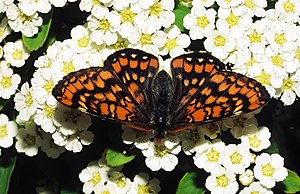May bird
| May bird | ||||||||||||
|---|---|---|---|---|---|---|---|---|---|---|---|---|

May bird ( Euphydryas maturna ) |
||||||||||||
| Systematics | ||||||||||||
|
||||||||||||
| Scientific name | ||||||||||||
| Euphydryas maturna | ||||||||||||
| ( Linnaeus , 1758) |
The Fritillary butterfly or Small Fritillary butterfly ( Euphydryas maturna , Syn. : Hypodryas maturna ), also ash fritillary called, is a butterfly ( butterfly ) from the family of Nymphalidae (Nymphalidae).
features
The moths reach a wingspan of 35 to 42 millimeters. They have black-brown wing tops with a pattern of orange and light spots arranged in bands. The undersides of the wings are orange and have a pattern of light and dark orange on the forewings, while light, black-edged spots dominate on the hind wings. The pattern on the underside of the forewing is particularly faded.
The caterpillars are about 30 millimeters long. They are colored black and have a striking, bright yellow markings. They have numerous, black-haired thorns.
The pupa is colored white with well-defined black spots. It has yellow warts on its abdomen.
Similar species
- Honeysuckle Butterfly ( Euphydryas intermedia )
Food of the caterpillars
The young caterpillars feed exclusively on the leaves of the common ash ( Fraxinus excelsior ). The older animals that have wintered eat well honeysuckle ( Lonicera xylosteum ), goat willow ( Salix caprea ), aspen ( Populus tremula ) and various other herbaceous plants.
habitat
The animals can be found in humid, light forests with large, young ash stands and areas overgrown with alder bushes . In Central Europe , their populations have declined sharply and have disappeared in many places.
Occurrence
They occur in Eastern and Central Europe, the Caucasus , Urals , Eastern Kazakhstan , Southern and Western Siberia , the Transbaikal region and Mongolia . But they only occur very locally and their populations are widely dispersed. You can find them at a height of 200 to about 1,000 meters. z. B. in Germany they are only found in the Swabian Alb , in the southern Steigerwald , near Leipzig and in the Marzoller Au near Bad Reichenhall .
Way of life
The moths lead a hidden existence and are very inconspicuous in their behavior. When butterflies are seen, they are mostly males. They like to sit on forest paths and suck on puddles. They are rarely found on flowers, they prefer the flowers of shrubs such as common privet ( Ligustrum vulgare ) and woolly viburnum ( Viburnum lantana ).
Their populations often fluctuate enormously from year to year. Well proliferating groups by also increasing overpopulation of usually after two or three years as parasites living flies and wasps heavily decimated. After such attacks, the moths only recover after years.
Flight time
The moths fly in one generation from late May to early July.
development
The females lay their conspicuously red colored eggs on the underside of ash leaves. To do this, they usually choose young bushes about two meters high. They deposit their entire supply in a multi-layered ice mirror measuring around one centimeter in diameter . The storage place is selected very precisely and must correspond exactly to certain temperature , humidity and light conditions. In years with large numbers of moths, this can also be recognized by the fact that several females lay on the same leaf. After hatching, the young caterpillars gradually begin to provide the entire leaf with a web in which they then live together. They only eat certain parts of the leaves and thus leave behind a typical damage pattern, consisting of dried up and curled leaves and their webs, by which they are very easy to identify. From the end of June the approximately one centimeter long caterpillars leave their plants and drop to the ground or fall off with the dry leaves. They hide in small groups in dry leaves to overwinter. Only in the following spring do they become solitary and now also feed on several types of plants. This is probably due to the fact that the moths always choose ash trees as storage plants, but the caterpillars anyway have a wide range of food. The adult caterpillars pupate in May.
Hazard and protection
They are seriously threatened with extinction and are among the most endangered species in Germany. In the Red List of Germany the species is classified as "critically endangered" (1), in Austria it is classified as "critically endangered" (2). It is listed in Annexes II and IV of the Habitats Directive . Their decline is attributed to habitat loss through forestry , wetland drainage and agricultural use. Another reason are insecticides , which can inhibit moulting and are mainly used against the processionary moth. Other butterfly species are of course also affected.
swell
Individual evidence
- ↑ a b c d e f g h i Heiko Bellmann : The new Kosmos butterfly guide. Butterflies, caterpillars and forage plants. Franckh-Kosmos, Stuttgart 2003, ISBN 3-440-09330-1 , p. 178.
- ↑ a b c Tom Tolman, Richard Lewington: Die Tagfalter Europäische und Nordwestafrikas , p. 175, Franckh-Kosmos Verlags-GmbH & Co, Stuttgart 1998, ISBN 3-440-07573-7
- ^ Office for Food, Agriculture and Forests Traunstein - Marzoller Au (8243-371)
- ↑ Federal Agency for Nature Conservation (Ed.): Red List of Endangered Animals in Germany. Landwirtschaftsverlag, Münster 1998, ISBN 978-3-896-24110-8
- ^ Federal Ministry for Agriculture, Forestry, Environment and Water Management (Ed.): Red Lists of Endangered Animals Austria. Checklists, risk analyzes, need for action. Part 1: Mammals, birds, grasshoppers, water beetles, netflies, beaked flies, Tagfalter Böhlau Verlag, Vienna 2005, ISBN 3-205-77345-4
Web links
- Moths and Butterflies of Europe and North Africa (English)
- Lepiforum e. V. Taxonomy and Photos
- Euphydryas maturna near Fauna Europaea
- Euphydryas maturna inthe IUCN 2013 Red List of Threatened Species . Listed by: World Conservation Monitoring Center, 1996. Retrieved February 26, 2014.
